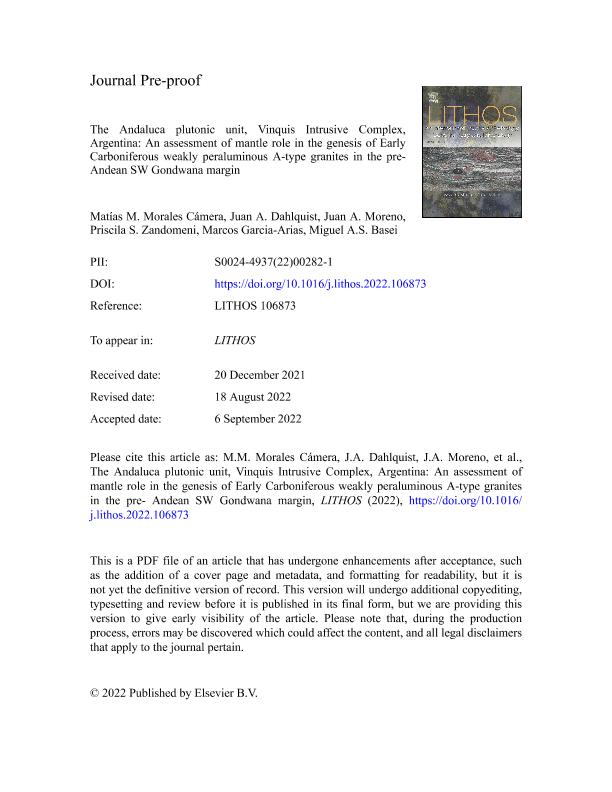Artículo
The Andaluca plutonic unit, Vinquis Intrusive Complex, Argentina: An assessment of mantle role in the genesis of Early Carboniferous weakly peraluminous A-type granites in the pre-Andean SW Gondwana margin
Morales Camera, Matías Martín ; Dahlquist, Juan Andrés
; Dahlquist, Juan Andrés ; Moreno Moreno, Juan Antonio; Zandomeni, Priscila Soledad
; Moreno Moreno, Juan Antonio; Zandomeni, Priscila Soledad ; García Arias, Marcos; Stipp Basei, Miguel Angelo
; García Arias, Marcos; Stipp Basei, Miguel Angelo
 ; Dahlquist, Juan Andrés
; Dahlquist, Juan Andrés ; Moreno Moreno, Juan Antonio; Zandomeni, Priscila Soledad
; Moreno Moreno, Juan Antonio; Zandomeni, Priscila Soledad ; García Arias, Marcos; Stipp Basei, Miguel Angelo
; García Arias, Marcos; Stipp Basei, Miguel Angelo
Fecha de publicación:
12/2022
Editorial:
Elsevier Science
Revista:
Lithos
ISSN:
0024-4937
Idioma:
Inglés
Tipo de recurso:
Artículo publicado
Clasificación temática:
Resumen
During the Early Carboniferous, significant intracontinental magmatism was developed in the retro-arc region of the SW margin of Gondwana between ca. 27° and 31°S. This magmatism consisted of metaluminous to weakly peraluminous A-type granites, strongly peraluminous A-type granites (A- to S- hybrid granitoids) and, to a lesser extent, (sub-)volcanic felsic (rhyolites and trachytes) and mafic (alkaline basalts and lamprophyres) rocks. The Vinquis Intrusive Complex (VIC) registers these two compositional varieties of A-type granites: the Vinquis Unit (VU) represents the strongly peraluminous granites and the Andaluca Unit (AU) the weakly peraluminous granites. The adjacent Zapata Intrusive Complex (ZIC) also contains metaluminous to weakly peraluminous A-type granites. The AU is a semi-elliptical plutonic body of approximately 60 km2 located in the southwestern part of the VIC, intruding the Vinquis Unit. The AU comprises three dominant rock types: i) quartz monzonite, ii) syenogranite and iii) alkali feldspar granite that can be classified as F-rich ferroan and weakly peraluminous A-type granitoids (calculated F content 1950–5700 ppm, [FeOt/(FeOt + MgO] = 0.86–0.95, ASI = 1.03–1.10, [Zr + Nb + Ce +Y] = 364–570 ppm, Ga = 20–23 ppm, SiO2= 68.5–75.1%). This unit was emplaced in early Carboniferous time with U-Pb zircon crystallization ages of 346 ± 3 Ma and 342 ± 3 Ma. The AU has 87Sr/86Srt, εNdt and εHft values ranging from 0.7092 to 0.7140, −2.6 to −3.6 and −16.5 to −3.3, respectively. These isotopic compositions suggest that the parental magma of AU involved variable mixtures of mantle-derived components (magmas/fluids) and peraluminous continental crust. The extremely felsic granites of the AU (SiO2 > ∼72%) have a strongly fractionated composition (Rb > 336 and Sr < 70 ppm and Eu/Eu* < 0.22) that suggests extensive fractional crystallization. The high contents of fluorine and HFSE could be explained as derived from a parental mafic magma rich in F, HFSE, and alkalis plus contributions from F-bearing minerals assimilated from the country rock. Magmatic differentiation of these reduced mafic magmas could also explain the ferroan character of the AU granitoids. We envisage three stages in the origin of these rocks: (1) fluids and magmas from the asthenospheric mantle metasomatize and melt the subcontinental lithospheric mantle (SCLM), the alkali-rich mafic melts produced are emplaced at the base of the crust, transfer heat to the crust and melt it, generating strongly peraluminous A-type magmas; (2) continued introduction of alkali-rich mafic magmas into the deep crust produces extensive assimilation of the preheated crust in equilibrium with mafic cumulates (generated by reaction and/or fractionation); (3) the hot magmas so produced migrate into the middle-upper crust as weakly peraluminous ferroan A-type granitoids.
Archivos asociados
Licencia
Identificadores
Colecciones
Articulos(CICTERRA)
Articulos de CENTRO DE INVEST.EN CS.DE LA TIERRA
Articulos de CENTRO DE INVEST.EN CS.DE LA TIERRA
Citación
Morales Camera, Matías Martín; Dahlquist, Juan Andrés; Moreno Moreno, Juan Antonio; Zandomeni, Priscila Soledad; García Arias, Marcos; et al.; The Andaluca plutonic unit, Vinquis Intrusive Complex, Argentina: An assessment of mantle role in the genesis of Early Carboniferous weakly peraluminous A-type granites in the pre-Andean SW Gondwana margin; Elsevier Science; Lithos; 434-435; 106873; 12-2022; 1-57
Compartir
Altmétricas



